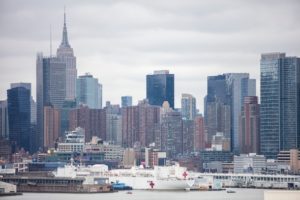
Sharif Ellozy, MD, has had just about as near to a front row seat as it gets to the part of the United States worst-hit by the COVID-19 pandemic—short of operating as an intensive care unit (ICU) or emergency room doctor, that is.
The Weill Cornell Medicine vascular surgeon operates in the heart of New York City, from where he has watched on as the coronavirus wends its way through the population.
Like many colleagues in the vascular specialty, Ellozy has been deployed in support roles, coming closest to the front when providing aspects of care such as line services. The burden and exposure, of course, is carried by the likes of ICU physicians, says the associate professor of clinical surgery in the division of vascular and endovascular surgery.
“The role of vascular surgeons is to support the people who are really the frontline people,” Ellozy—also a co-founder of the popular vascular surgery podcast, Audible Bleeding—tells Vascular Specialist. “The people who are at the front of this are really the intensive care doctors, the emergency medicine doctors, the anesthesiologists.

“From our standpoint, all of our elective practices have been postponed. What we are doing at my institution, means our main interaction is with the line services. So we are providing things like vascular access for the patients that need it. There are so many patients, the intensivists don’t have the capacity to do all the lines; they’ve got so many other things to do.” Other procedures carried out, notes Ellozy, include instances of acute limb ischemia and ruptured aneurysms.
Some colleagues have been re-deployed. “Two of our partners have been re-assigned to ICU; our vascular fellows have not been re-assigned yet; the residents are running on a weekend schedule,” he says. “Some have taken ill—thankfully they’re getting better—so had to take off for a little while. We want to minimize the likelihood of people getting sick.”
In any given system across the patchwork of hospitals in the five boroughs, the outbreak is being handled in varying ways, Ellozy explains. “Every hospital has a different set-up. One of my friends is at Mount Sinai [Hospital]. He’s a vascular surgeon but he’s not really working as a vascular surgeon. What happens is they go out and help out where they can throughout the system. He has been working in an ER [emergency room] in Brooklyn. It’s all hands on deck.”
At Weill Cornell, says Ellozy, there is positive news on the personal protective equipment (PPE) front. “Our institution seems to have done a very good job of getting PPE. We have enough supply that we’re ok. They’ve asked us to re-use the N95 masks to preserve them. We’re repurposing something that was originally single-use but we have N95 masks. It’s not like it’s been described elsewhere where there’s a lack of PPE for the practitioners.”
On the other side of the pandemic, as the outbreaks begin to wane and elective procedures re-enter the fray, he expects to see a deluge of cases. “A lot of people aren’t coming to the hospital out of a certain amount of fear among the general population because of the possibility of getting sick,” Ellozy says. “We may see a real surge in the amount of cases coming in once this has resolved.”
Meanwhile, he notes, in many instances enterprising trainees are taking possible deficits in their education into their own hands
“The concern is there is a big drop-off in operative volume for trainees,” Ellozy continues. “The one thing I think is really exciting is they’re really working on ways to supplement their education. We started going to remote learning using the Zoom platform. We’re seeing a lot of places where you have three or four residencies logging on to the same conference—there’s a lot of interaction with these other places—that is really one of the unexpected benefits. And it’s driven in large part by trainees themselves. Maybe that’s one of the things that comes out of this: collaboration across programs.”
The reinforcement of a vascular adage—that of the resourceful surgeon redolent of the specialty, from veteran to resident—is one of Ellozy’s chief takeaways from the crisis. “Vascular surgeons tend to be for the most part pretty resourceful and anticipatory, and also want to make an impact, and I have been very impressed with how people want to jump in and help out,” he muses. “It’s been very heartening.”
Both that and the public’s support for frontline healthcare professionals: “Every day at 7 p.m in New York City we have this situation—even though we’re sheltering in place—where people open their windows and start screaming, shouting, playing music and clapping. It’s very moving.”












